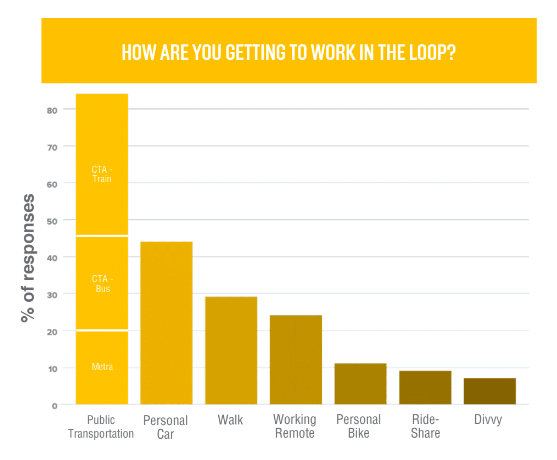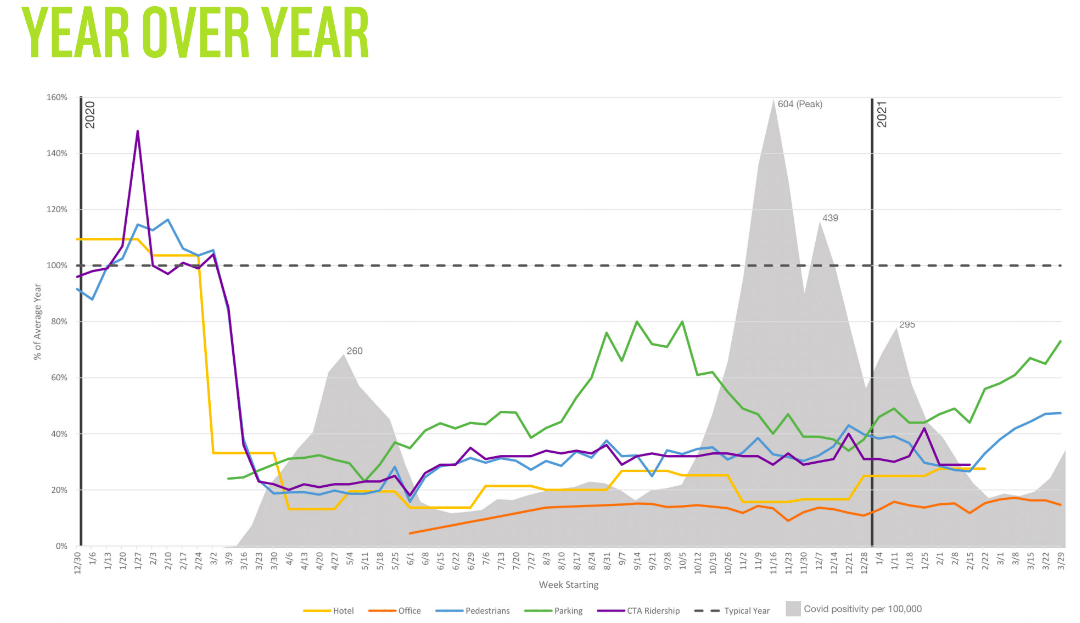Streetsblog has been following the monthly recovery reports issued by Chicago Loop Alliance, which aggregate data from pedestrian counters, parking rates, office building occupancy, and member surveys to track trends in economic and physical activity downtown during the pandemic. We’ve been paying close attention to the troubling rise in personal car use, with parking rates disproportionately higher than business activity and pedestrian counts compared to the same date in an average, pre-pandemic year. Unfortunately, the March report shows this trend continuing, with vehicle parking rates skyrocketing as the weather warmed and pandemic restrictions loosened.
Pedestrian activity rates on State Street rose steadily beginning in mid-February through late March, reaching their highest point since the beginning of the pandemic, right around 50 percent of the same date in an average year. Parking rates increased right alongside, hitting a whopping 75 percent of an average year by March 29th. With office occupancy remaining low, much of this increased activity can likely be attributed to recreational trips and a gradual reopening of shops, restaurants, bars, and other retail outlets. Over 60 percent of survey respondents said they visited the Loop during a weekend in March, nearly double that of February, and 55 percent said their businesses were open and operating, up from 37 percent in February.
CTA ridership rates for March weren’t yet available, but the Loop Alliance noted that CTA recently increased capacity rates on buses and train cars, anticipating a rise in demand. Another bright point in the report was the number of respondents who said they used public transportation to get to work, with significant increases in Metra, CTA bus, and train as commute modes. In February, the Loop Alliance reformatted the How Are You Getting To Work In The Loop graph to stack these three modes into a single “public transportation” column. While this formatting makes for a more optimistic transit graph and allows the Loop Alliance to state that “public transportation is the most popular way to get downtown,” looking at the data this way is misleading. Respondents can select more than mode in the survey—say if they use both bus and train, or if they drive some days and walk others—making it possible for the stacked “public transportation” bar to have more than 100 percent of respondents choose this category.

It’s also notable that while public transportation, walking and biking commutes all increased in March, personal car commutes remained constant, at about 45 percent of respondents. With the vaccine rollout underway, the return of some outdoor festivals this summer, and a light at the end of the pandemic tunnel in sight, personal vehicle use in Chicago is on the verge of reaching crisis levels. A true recovery for the Loop and all Chicago neighborhoods must include safe, affordable, and convenient public transportation with sufficient investment from government agencies and ridership from the community.
Recently columnists for Chicago's leading newspapers have expressed competing visions for the future of local transit. The Sun-Times' Laura Washington noted that if we want the CTA to survive the pandemic intact, we've got to be the change we want to see by continuing to ride it. Meanwhile the Tribune's Steve Chapman argued that, unlike every other segment of society, public transportation is never going to rebound from the pandemic, so we should stop funding it, a position that was described by former Trib transportation reporter Jon Hilkevitch as "dumb."





